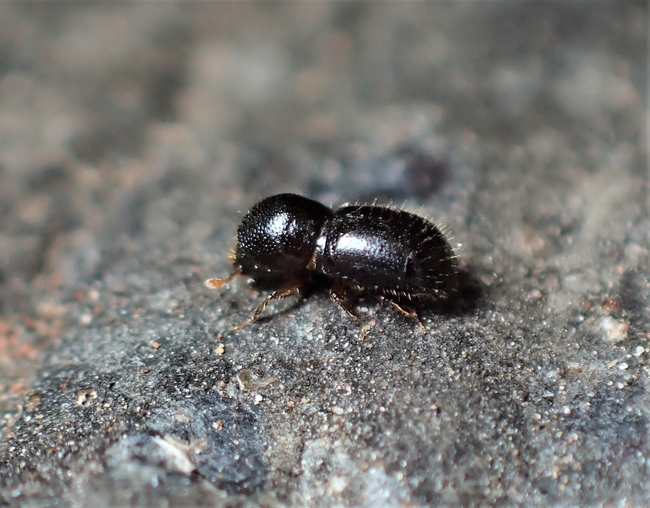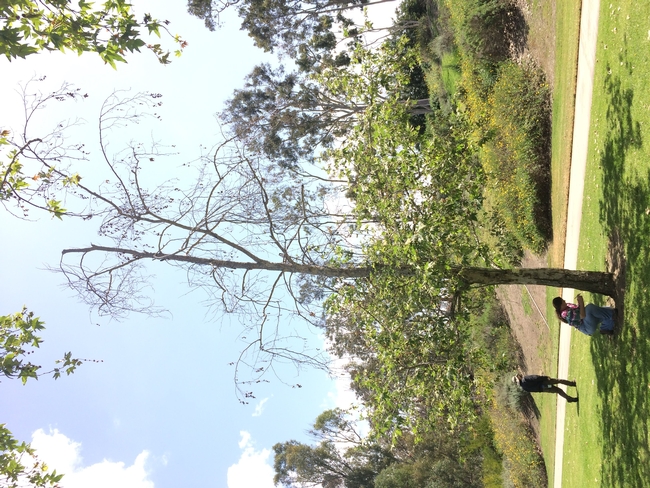Posts Tagged: natural resources
Good fire is back at the Hopland Research and Extension Center
Fire has been part of indigenous stewardship in California since time immemorial. These fire practices were deeply connected to cultural traditions, food ways, and enhanced the resilience of landscapes. Using fire for research and land management at the UC ANR Hopland Research and Extension Center (HREC) dates back to the early 1950s and fire was used as an effective tool for maintaining the health of the landscape for many years. However, the regulations and paperwork permitting controlled burns became increasingly restrictive after the catastrophic wildfires of 2017.
Thanks to three years of perseverance by John Bailey, HREC director, and with help from trained UC ANR advisors and staff, we were able to execute a research burn once again, instead of relying on the more restrictive CalFire Vegetation Management Plan process. By carefully reintroducing fire, a tool essential for rangeland and oak woodland stewardship, we want to be able to use good fire for research and to recover biodiversity and make the landscape more climate resilient.
On Nov. 8, 2024, HREC successfully conducted a prescribed burn as part of ongoing research to advance the restoration of a unique perennial wetland. This prescribed burn is part of a larger initiative to enhance native biodiversity and control invasive species. Fire was used as a natural disturbance to open up the dense Tule stands surrounding the pond to create a habitat mosaic with a diversity of plant species and habitat structure for native frogs and other pond life.
The burn was led by UCANR staff and academics, including Jeff Stackhouse, UC Cooperative Extension natural resource advisor, and Mike Jones, UCCE forestry advisor, whose leadership ensured its successful execution. We also had significant community participation from members of theHopland Band ofPomo Indians, including their Environmental Protection Agency director, as well as Grizzly Corps members, researchers and volunteers.
This event provided an opportunity for the diverse group to learn about controlled burns, engage in fire safety education, and explore how such practices contribute to ecological resilience. By involving community members in the process, the event not only restored habitat but also fostered a deeper understanding of fire's role in ecosystem health and stewardship.
HREC plans to work with UC ANR leadership and the UC ANR Fire Network to establish clear policies for conducting regular burns for research, stewardship and extension. Additionally, HREC will continue partnering with CalFire, leveraging their capacity for larger-scale projects, ensuring a variety of pathways are available for safely conducting prescribed fire and to strengthen the UC-CalFire relationship for better land stewardship outcomes statewide.
Virtual fencing ‘game-changer’ for ranchers grazing cattle
Tech can save ranchers time and benefit animals and land, becoming more viable
After the Caldor Fire destroyed seven miles of fencing on their cattle ranch in 2021, Leisel Finley and her family needed to replace the fence.
Finley, a sixth-generation rancher at Mount Echo Ranch in Amador County, said reconstruction costs were bid at $300,000 and would take at least a year to build, leaving the family without summer pasture and a herd of hungry cows to feed. Additionally, the U.S. Forest Service mandates that grazing be withheld for two years in postfire landscapes. This put the family in a difficult position.
While watching a recording of a California Cattlemen's Association meeting, Finley learned about a pilot program for virtual fencing. Desperate to find an alternative solution, she registered to try the livestock containment technology, which uses GPS enabled collars to monitor each animal's location in near real time.
Livestock producers can draw a perimeter on a map of their pasture using a laptop or smartphone application and send those instructions to the collar. The collar then uses audio and tactile cues to contain the animal in the area.
Eager to discover the short- and long-term benefits of virtual fencing, Finley turned to Scott Oneto, farm advisor, and Brian Allen, assistant specialist, from the University of California Cooperative Extension office in the Central Sierra. Since partnering with Oneto and Allen, Finley said she has come to understand and uncover more of the technology's potential.
The team has consistently observed the technology's value in integrating with and enhancing traditional livestock production systems across California. Though still in its early stages of development, the location tracking and containment system appears to provide time- and cost-savings that make it a game-changer for ranchers.
Ability to monitor location of animals in real time
Virtual fencing really stands out in its ability to monitor each animal's location in real time. During roundups, ranchers can use their smartphones to see their own location relative to their herd. The system can also send alerts if an animal crosses the virtual boundary or if a collar remains stationary for an extended period, potentially indicating that the animal is sick or that the collar has fallen off.
Rounding up cattle on large, forested grazing allotments can be challenging, as the process generally requires a group of people and many return trips to find every animal. Prior to virtual fencing, Finley and her father could gather about 85% to 90% of the herd in a week. Since using virtual fencing, Finley said one of their most recent roundups lasted three days, and they located every single cow.
Something that every livestock producer dreads is the notorious call from a neighbor or California Highway Patrol alerting them that one of their cows is out in the middle of the road. It always seems to happen at midnight or while they are out with friends or family. This scenario changes with virtual fencing.
Containment based on animal behavior
The containment system that virtual fencing is built on is based on animal behavior. When the animal crosses an invisible boundary, the collar emits an audio warning, prompting most animals to instinctively turn back into the desired area. If the animal doesn't respond, the collar delivers a mild electric pulse as a secondary deterrent.
Field trials by Oneto and Allen demonstrated the system's success. Recently, the team trained a herd of 37 cattle of mixed ages that had no previous exposure to virtual fencing. During the initial six-day training period, the cattle responded to the audio warning alone about 75% of the time when they approached a virtual fence boundary, with the remaining 25% of cases requiring an electric pulse.
After about three weeks, the herd was responding to audio cues alone about 95% of the time. The field trials also showed that the collars contain the livestock within the desired areas 90% to 99% of the time when the entire herd wears virtual fence collars and their basic needs for safety, connection to the rest of the herd, water, forage, shade, etc. are met.
Opportunities for improvement
While the technology is effective in its current capacity, there are notable areas where it can improve. One limitation to the system is the current reliance on cellular networks to operate. If an animal wanders into an area outside of coverage, the collar will continue to operate based on the last instructions but won't receive updates or report locations. This is especially a concern in many areas of California with poor cell reception, including the steep forested rangelands where many livestock producers have summer grazing allotments.
Another limitation is that some companies require a solar-powered base station with radio and cellular antennas to be placed on the pasture. These facilitate the transfer of animal locations and updates to the virtual fences. A base station going offline would create the same conditions as a drop in cell signal until the base station is repaired. Some companies are currently developing collars that bypass the need for these base stations.
The other major concern for ranchers is the cost for a virtual fencing system. The average rancher can expect to pay an estimated $20,000 to $30,000 in upfront costs. The cost to set up a base station alone is $5,000 to $10,000. However, this cost is highly dependent on several factors, including the manufacturer, the number of livestock to be collared, if the livestock are large or small ruminants, and the number of GPS base stations to cover the range.
According to Allen and Finley, the high cost of virtual fencing can be offset by the unique animal and land management benefits it can provide. “While physical perimeter fencing remains essential, VF is rapidly emerging as an innovative tool to control livestock with ease, precision, and flexibility in ways that were not previously feasible with traditional fencing,” Allen said.
Finley described the technology as a “game-changer” for her family.
Virtual fencing helps control invasive grasses, installing fuel breaks
While virtual fencing is designed to contain livestock without physical fencing, it is not intended to outright replace secure perimeter fencing. Instead, it operates best as a highly dynamic and adaptable cross-fence, allowing for more intentional grazing on the landscape to meet livestock production and natural resource conservation objectives within a secure physical perimeter.
With grant funding from the USDA Natural Resources Conservation Service, the UCCE team continues to work with Finley and other livestock producers to test these applications on California's diverse rangelands.
Within the Sierra Nevada and Coast Ranges foothills, these trials include using virtual fencing on cattle for targeted grazing of invasive grasses to support the recovery of native forage and installing fuel breaks within the wildland-urban interface to remove vegetation where the edge of a pasture meets urban housing.
Using virtual fencing, 25 cattle were successfully concentrated on a field of Medusahead (Elymus caput-medusae), an invasive annual grass. The herd respected the virtual fencing boundary 99% of the time despite nearby preferable forage. Grazing reduced medusahead seed heads from 2,072 per square meter in the ungrazed control area to just 68 per square meter in the grazed section.
In a different trial, 37 cattle with virtual fencing collars were contained within 120-feet-wide fuel breaks along the boundary of an annual rangeland and residential area. Cattle stayed within the boundaries 99% of the time, leading to an 81% reduction in fine fuel biomass and lowering wildfire risk in the wildland-urban interface.
Within rangelands on conifer forests, these UCCE trials concentrate cattle on brush to reduce the flammable plants and vegetation that competes with desirable timber species. It also can prevent livestock from entering sites that are sensitive to livestock presence.
Upcoming grazing trials will focus on how virtual fencing works with goats and sheep. In addition to Oneto and Allen, UCCE's contribution to virtual fencing research is in large part due to Leslie Roche, UCCE specialist and associate professor at UC Davis, Dan Macon and Jeff Stackhouse, UCCE livestock and natural resources advisors, Kristina Horback, associate professor at UC Davis and Lone Star Ranch in Humboldt County.
To learn more about the trials led by the UCCE team,visit https://cecentralsierra.ucanr.edu/Virtual_Fencing/
UC ANR experts, resources guide response to shothole borers in Bay Area
UC Cooperative Extension scientists, partners managed invasive beetle in Southern California
Late in 2023, a potentially devastating beetle was detected in the San Francisco Bay Area for the first time. But land managers, arborists and agency staff have one big advantage as they devise plans to control the invasive shothole borers (ISHB).
Thanks to collaborations led by University of California Agriculture and Natural Resources, they can draw upon the hard-earned experience of their colleagues in Southern California. Over the past decade, SoCal communities have lost “tens of thousands” of trees due to ISHB infestations, according to Beatriz Nobua-Behrmann, UC Cooperative Extension urban forestry and natural resources advisor for Los Angeles and Orange counties.
In one regional park, about 500 trees had to be removed in the span of just one year. “That kind of impact happened in many locations; a whole street might lose 90% of the trees – all of a sudden,” said Nobua-Behrmann, a member of a statewide network studying ISHB.
Spurred by such severe impacts, UC scientists have been studying ISHB and testing various control measures since about 2012. Their lessons are now informing efforts in San Jose – where the first case in the Bay Area was detected in November 2023 – and across the region.
“The UC ANR team is comprised of subject-matter experts,” said Drew Raymond, interim agricultural commissioner for Santa Clara County. “The team has compiled all of the experience from the agencies that have been doing work in Southern California and transplanted that experience here to Northern California.”
Lucy Diekmann, UC Cooperative Extension urban agriculture/food systems advisor, and Igor Lacan, UCCE environmental horticulture and urban forestry advisor, have coordinated regular meetings and trainings of Bay Area agricultural officials, land managers and arborists.
“Lucy and Igor have been instrumental in organizing our partners to establish an effective plan for shothole borers,” said Sara Davis, city forester for San Jose. “Because experts across the broader UC ANR network have many years of firsthand experience with this invasive pest, we are able to draw on their practical know-how to guide our monitoring, management and public education efforts.”
Davis is leading a trapping program in San Jose to determine how widespread ISHB is. Aside from a recent detection in the Santa Cruz Mountains, almost all of the approximately 30 confirmed cases in Northern California have been clustered along the riparian corridor of Coyote Creek through downtown San Jose. This pattern of intense but geographically limited damage was also seen across Southern California – notably in San Diego County along the Tijuana River Valley, where ISHB wiped out the willow population.
“I would expect us in the Bay Area to see this type of localized damage that is not fundamentally different from what they're seeing in Southern California,” Lacan said.
Unusually troublesome pest triggers deadly tree disease
The invasive shothole borers – a term for two species that are virtually indistinguishable, the polyphagous shothole borer and Kuroshio shothole borer – were first detected in Los Angeles in 2003. The tiny beetles, measuring 1.5 to 2 millimeters in length, became a major concern a decade later when swaths of urban forest began dying across LA County.
Infestations are harmful – and fatal for at least 17 tree species in California – because the fungus that the beetle “farms” as its food source causes a disease called Fusarium dieback. Alarmingly, ISHB make their home in a wide variety of trees; Nobua-Behrmann said 65 tree species in California have been identified as “reproductive hosts” where they can grow their populations.
“The fact that they are such a generalist species means that they can find a host almost anywhere,” she said, noting that sycamore, box elder, cottonwoods, oaks and willows are favorites of ISHB.
Furthermore, typical tools in the integrated pest management toolbox are unavailable or ineffective for this invasive beetle. Unlike most insects, these shothole borers mate with their siblings before leaving the tree, so they don't need to search for mates afterward. This means they are not attracted to the pheromone traps typically used for pest control; traps used for ISHB only work to track their numbers, not reduce them.
“Their biology limits what we can do,” Nobua-Behrmann said. “Since the beetles spend most of their lives inside the trees, it's also hard to reach them with insecticides.”
Largely hidden within trees, ISHB can build up their numbers, undetected for years. A tree with green and plentiful leaves may in fact be harboring a significant infestation. “It's easy for this beetle go under the radar and create a big population and a big problem before you even notice,” Nobua-Behrmann said.
Monitoring and early identification of infestations are crucial
Given this pest's elusive nature, monitoring and early intervention have proven to be essential in Southern California.
“All of the success stories have a major component of monitoring and detection; if you have a good monitoring program and you can quickly identify the trees that are infested, timely action can make a big difference,” said Nobua-Behrmann, citing Disneyland in Anaheim as one example where frequent surveys and robust monitoring prevented major impacts.
As most municipalities don't have the abundant resources of a world-famous theme park, Nobua-Behrmann pioneered a program in Southern California to train community members on recognizing telltale signs of the beetle. Specifically, they looked for its entry holes, which have a characteristically round shape and size, comparable to the tip of a ballpoint pen.
Beginning with UC Master Gardeners and UC California Naturalists and then members of the general public in LA and Orange counties (and later other SoCal counties), the program trained about 100 people on how to look out for the beetle. After verification by experts, volunteers were found to be nearly 90% accurate in identifying ISHB.
Although the volunteer monitoring program is on hiatus, Nobua-Behrmann said it had clear benefits that could potentially help other regions. “It would be great to get this program going in Northern California and hopefully get volunteers and people in the general public to help identify infestations there as well,” she said.
Statewide ISHB network spreads essential information
In addition to coordinating an in-person public training in San Jose in April, Lacan and Diekmann, the UC Cooperative Extension advisors, have been educating local UC Master Gardeners on how to spot signs of the invasive beetle.
For about a decade, Lacan has been warning people about the possibility of ISHB in Northern California, routinely including shothole borers in his presentations on “tree pests to watch.” “I've been doing this since before ‘day zero,' but there was not a whole lot of interest in ISHB, as you might imagine,” Lacan recalled. “But then all of that changed in fall of last year.”
In the past year, Lacan has done a dozen ISHB presentations, workshops and webinars, attended by a total of about 260 people – predominantly city foresters, land managers, production arborists and members of tree-related nonprofits.
Lacan noted that the most effective presentations have been at in-person events featuring UC ANR-affiliated experts such as Nobua-Behrmann, UCCE environmental horticulture advisor emeritus John Kabashima, and ISHB program staff Randall Oliver and Hannah Vasilis.
“Here is where we tap into our network,” Lacan said. “This is the power of the statewide shothole borers program.”
Another vital asset has been the collection of practical resources gathered by the ISHB program, the UC Integrated Pest Management team and partner organizations. One example is a deck of identification cards depicting how symptoms of infestation differ from species to species. Such detailed information can help managers determine whether a tree is truly infested – and thus allocate their limited resources more judiciously.
“These very specific, very seriously considered materials are the kind of thing that people really appreciate,” Lacan said. “It's not just a generic ‘it's kind of like this.'”
The symptoms, broken down by tree species, are also listed on the ISHB website. Raymond, the interim agricultural commissioner for Santa Clara County, said his team uses the website to get informed about ISHB and regularly refers community members to it.
“The ISHB website has been a great resource,” Raymond said. “It's full of important and user-friendly information.”
Communities learn to protect trees, adapt to shothole borers
If community members believe a tree is infested, they should review the symptoms of ISHB-Fusarium dieback. If the signs match what they are seeing, they should take a photo of the entry hole (with the tip of a ballpoint pen placed next to the hole as reference) and send images to their county agricultural commissioner's office or local UCCE advisor, who may then seek confirmation.
Extra eyes on urban forests are crucial to help experts identify potential “amplifier trees” – heavily infested trees, with more than 150 entry holes, that are often repeatedly reinfested by subsequent generations of beetles. They contribute to the recurring pattern of severe but localized infestations seen across Southern California – and now in San Jose.
New research suggests that removing severely infested trees – or just the most impacted limbs of those trees – can significantly lower the overall ISHB population and help less-infested trees in the area recover over time.
“You're not going to eradicate ISHB (at least not in Southern California); you're not going to get rid of them – you're going to have them forever,” Nobua-Behrmann said. “But you can keep them at a manageable amount.”
She also emphasized other actions the public can take to prevent the spread of ISHB, such as correctly disposing infested plant material – ideally chipping it to less than an inch in length (or as small as possible) and then composting the chips.
“It's also important to not move firewood and instead buy it where you will be burning,” Nobua-Behrmann said. “It's one of the best things people can do to protect trees from invasive pests.”
After identifying and removing amplifier trees, land managers and landscape arborists should have a plan for replanting, Lacan added. He said they should prioritize species that are less susceptible to the beetle, using his Pest Vulnerability Matrix tool that lists the major pests for different mixes of trees.
“We need to figure out how to have sustainable urban forests, even with this pest,” he said. “We know we can do it, largely thanks to our colleagues in Southern California. So the key lesson is to replant soon – choose smartly, but replant right away.”
Water discussion on Sept. 29 flows from LA art exhibit
Communities in Los Angeles and around California face a variety of water challenges ranging from access to clean, affordable water to water supplies threatened by a changing climate.
The public is invited to a free event featuring a panel discussion of the past, present and future of Los Angeles water. The water discussion will be part of the closing reception for the art exhibit “What's On Tap: LA's Water Story…Source to Spigot” at El Tranquilo Gallery in Los Angeles on Sunday, Sept. 29.
“I hope that people come away understanding that our relationship to and stewardship of water in LA is not only a critical part of our past history, but essential to determining our region's future as well,” said Edith B. de Guzman, UC Cooperative Extension specialist for water equity and adaptation policy with UC Agriculture and Natural Resources and UCLA Luskin Center for Innovation.
The panel will be moderated by UCLA Public Policy Professor Megan Mullin. Panelists will include de Guzman; Amanda Begley, watershed senior program manager for TreePeople; Conner Everts, facilitator for the Environmental Water Caucus, executive director of the Southern California Watershed Alliance, and co-chair of the Desal Response Group; and Mark Gold, director of water scarcity solutions for the Natural Resources Defense Council.
The discussion will be followed by a blind water tasting. Participants will be able to taste how the flavors of three brands of bottled water compare with each other and Los Angeles Department of Water and Power tap water.
“Thus far, many people have chosen LADWP tap as their favorite compared to the bottled brands,” de Guzman said. “So another hope I have is that people will come away with greater appreciation and trust of tap water.”
The art exhibit, curated by Edith and Jolly de Guzman, highlights five distinct water themes that affect Southern California communities – local water, imported water, tap trust, human right to water and affordability.
The Zanja Madre, a Spanish-era aqueduct that moved water from the Los Angeles River to the pueblo of Los Angeles between 1781 and 1904, once ran past the gallery location.
The “What's On Tap: LA's Water Story…Source to Spigot” exhibit will be open from 11 a.m.-3 p.m. Friday through Sunday, Sept. 27-29, with the closing reception 3-6 p.m. on Sunday, at El Tranquilo Gallery, W-19 Olvera Street, Los Angeles 90012. The panel discussion will begin at 4 p.m. The reception will include live music by Shoshana Ben-Horin.
Hands-on learning, training make irrigation best practices accessible
UCCE advisors provide free training to nursery and greenhouse staff
Working as an irrigator seems straightforward at first: if you're not watering plants by hand, you're building and managing systems that can do the watering. What could be complex about a job like this?
University of California Cooperative Extension advisors Bruno Pitton and Gerardo “Gerry” Spinelli can tell you – or better yet, show you.
Pitton and Spinelli, members of the UC Nursery and Floriculture Alliance, offer a one-day technical training in irrigation best-management practices for irrigators working with containerized nursery plants. The comprehensive curriculum – developed with input from two focus groups of California nursery and greenhouse managers – aims to improve irrigation efficiency, reduce water consumption and improve plant health.
Thanks to funding from the California Department of Food and Agriculture, nursery and greenhouse managers in California can request this training for free and advisors like Pitton and Spinelli will travel to conduct the training on-site.
The complexities of irrigation incorporate concepts like evapotranspiration, salinity, irrigation uniformity, capillarity, pressure and flow rate. Spinelli, UCCE production horticulture advisor for San Diego County, said that irrigators have a critical role in the industry because of all the things they must consider to do their job well.
“Our goal is to support irrigators and help them become more confident decision-makers and experts in the field,” said Pitton, UCCE environmental horticulture advisor for Placer and Nevada counties.
Interactive sessions reveal nuances of irrigation
The training consists of a presentation on fundamental concepts for managing irrigation in container plant production and hands-on demonstrations. “In the nursery industry, where precise irrigation is crucial for the health and productivity of our crops, having access to expert knowledge is invaluable,” said Mauricio de Almeida, general manager of Burchell Nursery in Fresno County. “The training's practical demonstrations and real-world examples made the concepts easy to grasp, allowing our team to implement the strategies immediately.”
For one of the demonstrations, the advisors used sponges to model soil saturation when water is applied. Ana, an irrigator at Burchell Nursery, appreciated the step-by-step explanations, which helped her better understand how water pressure differs in drip irrigation, sprinklers and watering by hand. Doing this out in the field, as an example of how irrigation audits occur, was extremely helpful for attendees.
Francisco “Frank” Anguiano, production manager of Boething Treeland Farms in Ventura County, observed his team of irrigators as they learned how to measure distribution uniformity with water collected from sprinklers. “This training isn't just about irrigation and plant management. It's also about savings, both water and costs. Who doesn't want to save money and use less water?” Anguiano said.
Reducing the barriers to learning
Many of the irrigators attending these trainings gained their skills and knowledge from life experience rather than a college education, explained Peter van Horenbeeck, vice president of Boething Treeland Farms. “It's important that my irrigators learn from external experts, but it's more important that they can relate to them. And that's what Gerry was able to do,” van Horenbeeck added.
Regarding content and delivery, and referencing what he learned from the focus groups, Pitton wanted the trainings to be easy to understand and engaging. For example, scientists use the term “matric potential” to describe how soil particles hold water against gravity, which is the same as capillary rise. “We demonstrate this concept with a paper towel held vertically and dipped into a beaker of dyed water that it absorbs,” said Pitton.
Many of the irrigators in attendance agreed that hands-on activities and visual aids were instrumental to their learning. Charli, another irrigator at Burchell Nursery, shared that the in-field examples and hosting the training in Spanish kept them engaged.To address language barriers, Spinelli has been conducting trainings in Spanish – a common request from many nurseries with eager participants.
Maintaining state regulations and partnerships
Although the technical aspects of irrigation management are key elements of the training, regulatory compliance is also addressed. Recognizing the finite availability of water and the environmental impact of pollution, the advisors highlight irrigation and fertilizer management and runoff prevention as critical components of compliance.
Under Ag Order 4.0 administered by California's Water Resources Control Board, growers must comply with stricter policies regulating nitrogen use. As irrigators learn from the training, better control of irrigation can certainly make a difference.
Deanna van Klaveren, chief operating officer and co-owner of Generation Growers in Stanislaus County, said the most valuable aspect of the training was learning on-site and completing an audit on her own systems. “It is so much more impactful to have trainings like this on-site where our staff can learn and then go out into the nursery and actually put it into practice while the presenters/experts are there,” van Klaveren said.
Pitton and Spinelli described the partnership between UC Cooperative Extension and CDFA as “symbiotic” given the technical and educational capacity of UCCE advisors who conduct research and extension.
“It's a great example of how the two institutions can collaborate successfully. Californians are the ones who win because they get a service for free,” added Spinelli. “And it's rewarding for us to see so much interest in what we, as advisors, do.”
If you are a nursery or greenhouse operator and would like to request the Irrigation Best Management Practices training, please contact the UCCE advisor assigned to the region that corresponds with your nursery location below.
Northern California
- Jessie Godfrey, UCCE environmental horticulture and water resources management advisor, jmgodfrey@ucanr.edu
Central Coast (Santa Cruz County to Ventura County)
- Emma Volk, UCCE production horticulture advisor, evolk@ucanr.edu
San Joaquin Valley
- Chris Shogren, UCCE environmental horticulture advisor, cjshogren@ucanr.edu
Southern California
- Grant Johnson, UCCE urban agriculture technology advisor, gejohnson@ucanr.edu
Spanish Trainings Only
- Gerry Spinelli, UCCE production horticulture advisor, gspinelli@ucanr.edu























